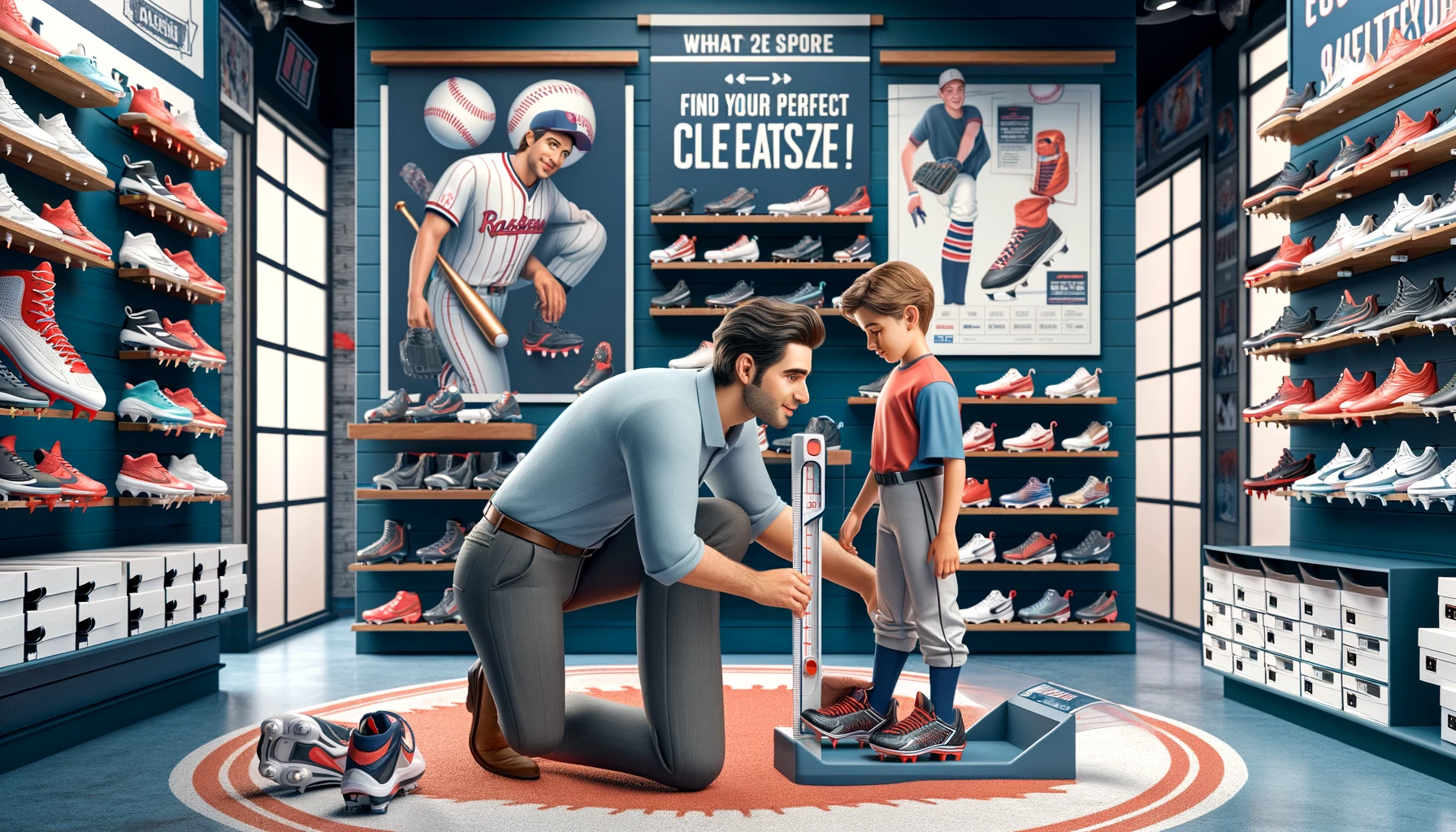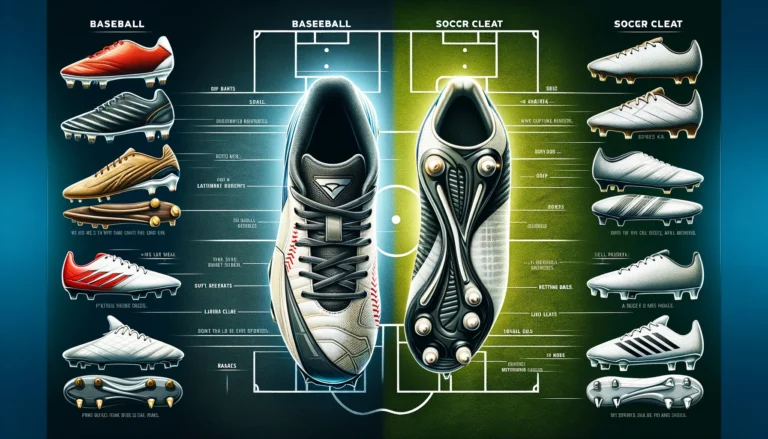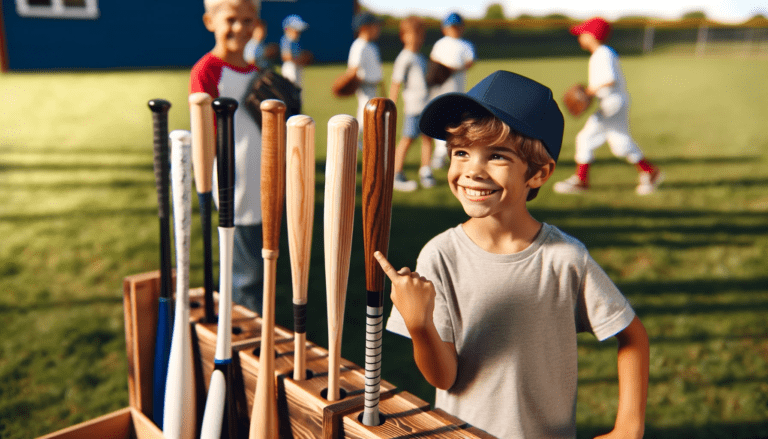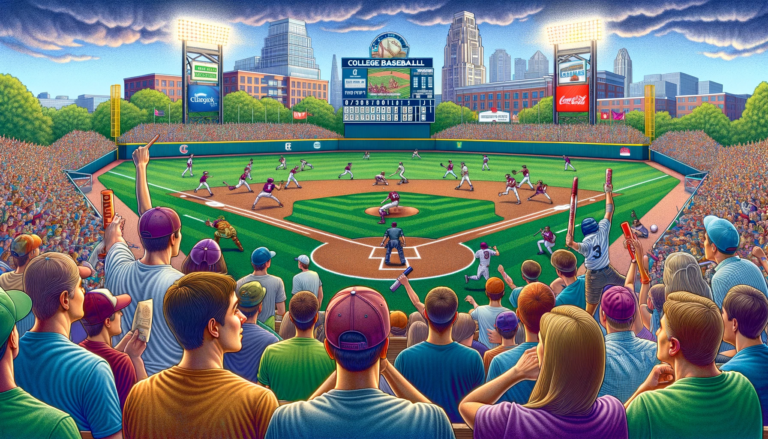What Size Baseball Cleats Should I Get for My Feet?
Choosing the right size of baseball cleats can be tricky. Wearing cleats that are too small will cause discomfort and blisters, while oversized cleats can lead to ankle injuries and poor traction.
Many baseball players make the mistake of picking cleats based on their regular shoe size, which often leads to an ill-fitting pair. This can severely impact your performance on the field and even cause long-term foot problems.
To get the perfect fit, you need to understand how baseball cleats are sized differently from regular shoes.
This article will guide you through the process of measuring your feet correctly and selecting the ideal cleat size based on your measurements and the specific brand’s sizing chart.
By following these simple steps, you’ll be able to find a pair of baseball cleats that provide the necessary support, traction, and comfort to elevate your game on the diamond.
Key Takeaways
- Baseball cleat sizing should be determined using a size chart specific to baseball cleats, considering both length and width for a comfortable fit.
- When between sizes, sizing up is recommended, especially for wide feet, to avoid discomfort and blisters, with the option to wear extra socks for a snugger fit.
- The choice of cleats should be influenced by the player’s position and the type of playing surface, with options like detachable studs for versatility.
- Comfort and support are paramount, with features like breathability, padded insoles, and material choice playing a significant role in the longevity and fit of the cleats.
- Before making a purchase, understand the return policy, evaluate the price versus value, and consider various purchasing options, including specialized sports stores and online platforms.
Understanding Baseball Cleat Sizing

Interpreting the Size Chart
When selecting baseball cleats, accurately interpreting the size chart is crucial for comfort and performance.
Baseball cleat size charts vary by brand and style, so it’s important to consult the specific chart for the baseball and softball cleats you’re interested in.
Here are some steps to guide you:
- Determine your size based on the chart provided by the brand. If your foot measurement falls between two sizes, it’s generally recommended to size up for a better fit.
- Use the heel-to-toe length measurements to find your corresponding shoe size. This measurement is more reliable than simply choosing by your regular shoe size.
- Pay attention to the width options if available. Baseball cleats come in different widths to accommodate various foot shapes.
Remember, the right size ensures a snug fit without being too tight, allowing for optimal movement and stability on the field.
If your measurement is between chart numbers, we recommend sizing up. Be sure you’re putting your full weight on your foot while tracing to get the most accurate measurement.
Tips for Measuring Your Foot
To ensure you get the best fit for your baseball cleats, it’s crucial to measure your feet accurately.
Start by gathering the necessary items: socks you’ll never wear athletic socks along with the cleats, a piece of paper, a pencil, tape, and a ruler.
Place the paper on a hard surface against a wall and stand on it with your heel flush against the wall.
Wearing your socks, mark the longest part of your foot on the paper and measure the distance from the mark to the bottom of the wall. Do this for both feet, as they may differ in size.
Once you have your measurements, compare them to the size chart provided by the cleat manufacturer. If your measurements fall between sizes, opt for the larger size to ensure comfort during play.
Remember, it’s better to have a little extra space than to squeeze into a cleat that’s too tight, which can lead to blisters and hinder your performance on the field.
Choosing Between Half Sizes
When selecting baseball cleats, the decision between half sizes can be crucial for achieving the perfect fit.
Here are some tips to guide you:
- If you find yourself in between sizes, opt for the larger half size to allow for slight swelling of the feet during play.
- Consider the width of your feet. Brands like Under Armour may offer a roomier fit for wider feet, which can influence your choice between half sizes.
- Remember that the fit can vary between different models and brands. It’s worth trying on multiple options to see which provides the best comfort and support.
Always check the return policy, as some stores offer free returns and exchanges, allowing you to test out different sizes without financial risk.
Ultimately, the right half size will contribute to superior traction and confidence on the field, as highlighted by Batter Box Sports’ top molded baseball cleats.
Read Also: Can You Wear Baseball Cleats for Lacrosse
Selecting Cleats Based on Position and Performance
Cleat Types for Different Playing Positions
The type of baseball cleats you choose should be tailored to your specific position on the field. Each position has unique demands that require different features from a cleat.
For instance:
- Pitchers benefit from cleats with reinforced toe areas to withstand the repetitive dragging motion during their delivery.
- Infielders often opt for low-cut cleats that allow for quick lateral movements and better agility.
- Outfielders may prefer high-cut cleats that provide extra ankle support for running across vast stretches of the field.
Selecting the right cleat type not only enhances performance but also reduces the risk of injury. It’s crucial to consider the balance between speed, stability, and support when making your choice. Remember, the right types of cleats can be a game-changer in how you play and move on the baseball diamond.
The Impact of Playing Surface on Cleat Choice
The playing surface is a critical factor when selecting baseball cleats. Natural grass and artificial turf require different types of traction, which is why it’s essential to choose the right cleat type.
For natural grass, molded synthetic leather cleats with permanently attached studs are often preferred. These studs dig into the soil, providing better traction, especially in wet conditions.
On artificial turf, players may opt for turf shoes that have smaller, more compact studs. These provide adequate grip without damaging the turf.
Some athletes credit turf for helping them run faster; they claim the surface feels easier to grip with their plastic cleats, allowing them to accelerate. However, it’s important to avoid using molded cleats on turf as they can be too aggressive, leading to a higher risk of injury.
For those who play on both types of surfaces, detachable cleats offer the ultimate versatility. You can switch between soft studs for grass and hard spikes for turf, ensuring optimal performance and safety.
Remember, the right cleat not only enhances your game but also helps in preventing injuries.
The Role of Cleats in Player Movement and Stability
The right baseball cleats are essential for ensuring both optimal movement on the field and player stability. Cleats designed for specific positions cater to the unique demands of those roles.
For instance, a pitcher’s cleats may prioritize stability and traction for the mound, while an outfielder’s cleats might be lighter for swift movements.
- Linemen cleats: Higher ankle support and longer spikes for ground resistance.
- Skill position cleats: Lightweight with shorter spikes for agility.
- Kicker cleats: Similar to soccer cleats for precision.
Choosing cleats with the appropriate spike length and support can make a significant difference in a player’s performance.
Detachable cleats offer versatility, allowing players to adjust turf cleats to different playing surfaces and conditions.
Molded metal cleats, with their permanent studs, provide a stable and supportive base, crucial for maintaining balance during the game’s dynamic plays.
Read Also: Can You Wear Metal Cleats in High School Baseball
Comfort and Support Considerations
The Importance of Proper Fit
Ensuring a proper fit in baseball cleats is crucial for both comfort and performance on the field. A well-fitting cleat will enhance a player’s stability, traction, and overall movement, allowing them to focus on the game rather than discomfort.
Here are some key considerations:
- Measure your feet regularly: Feet can change size over time, so it’s important to measure them before making a new purchase.
- Try on cleats with your game socks: This will give you the most accurate feel for how they will fit during play.
- Check for snugness without tightness: The cleats should be tight enough to prevent sliding inside the shoe but not so tight as to cause blisters or restrict circulation.
- Leave a thumb’s width of space: There should be about a thumb’s width of space between the end of your longest toe and the front of the cleat to ensure enough room for movement.
Customer feedback often highlights the importance of fit, with many noting that a good fit contributes to the cleats’ comfort and durability.
Remember, a cleat that fits well not only improves your game but can also prevent injuries and extend the life of the your athletic shoe itself.
Materials and Maintenance for Longevity
Choosing the right materials for your baseball cleats is crucial for both comfort and longevity.
Leather cleats are often favored for their durability and support, particularly by players who prioritize stability over speed.
On the other hand, synthetic materials are lighter and can benefit players who rely on quick movements.
To ensure your cleats last as long as possible, regular maintenance is key:
- Clean your cleats after each practice and game to prevent dirt and mud from causing damage.
- Avoid harsh chemicals and abrasives; instead, opt for milder cleaning solutions that are gentle on the cleats’ material.
- Condition leather cleats to maintain their flexibility and prevent cracking.
Remember, well-maintained cleats tend to not only last longer but also provide consistent performance and comfort throughout their lifespan.
Comparing Football and Baseball Cleats
When selecting cleats, it’s crucial to understand the differences between those designed for football and baseball.
Baseball cleats are typically lighter than football cleats, as they are not intended to provide the same level of impact protection.
The sole design of baseball cleats often features molded rubber or plastic with smaller studs, optimizing traction for the diamond’s demands.
Key distinctions include:
- Baseball cleats may have metal spikes for enhanced grip, which is prohibited in football.
- Football cleats are designed with toe studs and come in varying cuts for different positions, offering more ankle support and spike length customization.
- The overall build of football cleats is more robust to accommodate the sport’s physical nature, whereas baseball cleats prioritize agility and quick movements.
Understanding these differences is essential for athletes to choose the right cleats that align with their sport’s specific requirements and their personal performance needs.
Read Also: How To Clean Baseball Cleats
Conclusion
Finding the right baseball cleats is key to playing comfortably, doing your best, and staying safe from injuries on the field. This guide has shown you why getting the right size and fit matters a lot. It also covers what to look out for depending on where you play and your position on the team.
Make sure to look at the size chart to pick the best fit for you. If you’re not sure, it’s better to go a bit bigger to keep your feet from hurting. You might choose light cleats for faster running or ones with changeable studs for different fields. The right pair will help you play better.
Take good care of your cleats, and they’ll be there for you game after game. Walk onto the field with confidence, knowing you’ve picked the top cleats for your needs in baseball.
Frequently Asked Questions
How do I interpret the size chart for baseball cleats?
To interpret the size chart, match your foot’s measurement in inches to the corresponding US size. For example, a heel-to-toe measurement of 9.9 inches corresponds to a US size 7. Always compare your measurements with the specific brand’s size chart for the best fit.
What tips can you provide for measuring my foot for cleats?
Measure your foot by placing it on a piece of paper and marking the longest toe and the back of the heel. Use a ruler to measure the distance between the two points in inches. Do this for both feet and use the larger measurement when selecting your cleat size.
Should I choose a half size larger when buying baseball cleats?
If you’re between sizes, it’s generally a good idea to size up, especially purchasing cleats if you have wide feet. Cleats that are too tight can cause discomfort and blisters. You can compensate for extra space with thicker socks if needed.
What should I consider when selecting cleats based on my playing position?
Your playing position will influence the type of cleats you need. For example, infielders may prefer low-cut cleats for agility, while outfielders might opt for mid or high-cut cleats for extra ankle support. Consider your position’s demands when choosing cleat style.
How do I ensure my baseball cleats provide both comfort and support?
Look for cleats that offer a snug fit without being too tight. Features like breathable materials and padded insoles can enhance comfort. Ensure the cleats are flexible enough to allow natural foot movements while providing stability during play.
What is the difference between football and baseball cleats?
Baseball cleats are typically lighter than football cleats and have smaller studs or spikes for better traction on the diamond. They also often include toe studs for stability. Unlike football cleats, many baseball cleats have metal spikes, which are not suitable for football.







